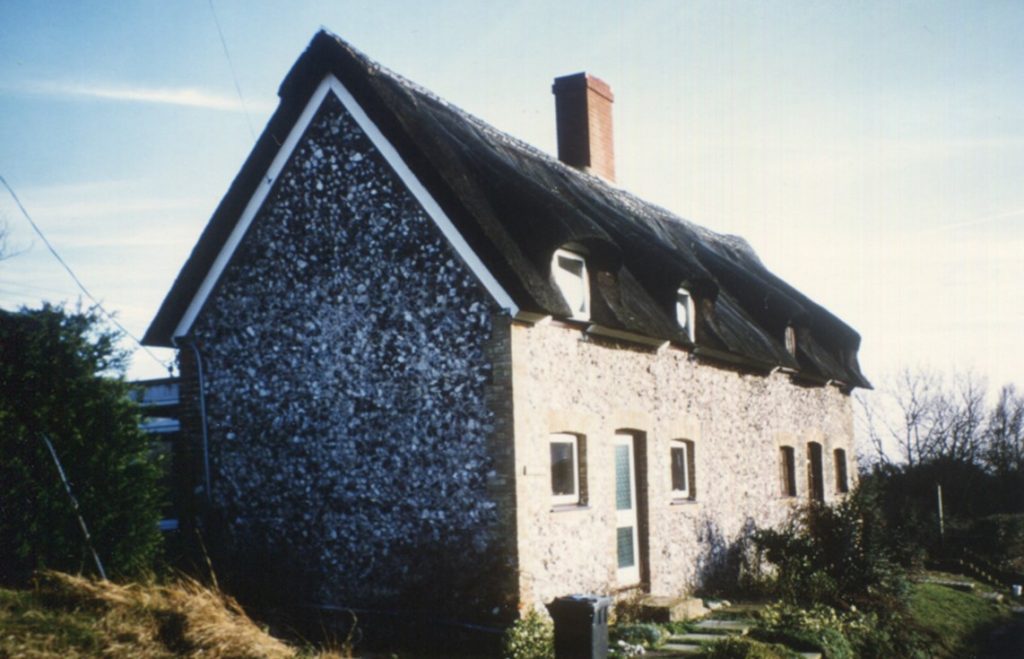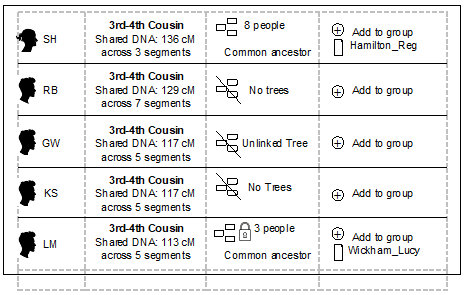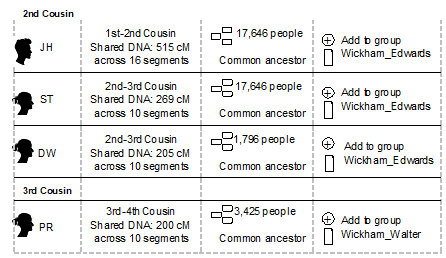By Linda Butler
This article was published in the April 2021 edition of Soul Search, the Journal of The Sole Society
There isn’t much to thank COVID for, but for me there were a couple of positives: the range of jigsaw puzzles available is vastly improved and a lot more people seem to be turning to family history to occupy their time during lockdown.
I’ve been surprised at the number of quite close cousins my husband and I have become (re)acquainted with over the last year. They all came about through Ancestry DNA matches or through searches of on-line trees.
These recent connections have got me thinking again about DNA and how it might, at a very practical level, be put to use for the benefit of Sole Society members. I am not going into a detailed discussion of the ins and outs of DNA testing, most of which is, in any case, way beyond my high school scientific knowledge. Rather, I want to suggest a practical application that came to mind. I’ll use my own research to explain my proposal.

6 The Street, Kelshall where Linda’s Sole family lived for several generations
Both my husband (Melvyn Butler) and I have Sole roots. I have been researching our families for over 40 years now. Like everyone doing family history, I have encountered a number of brick walls. About three years ago Mel and I both did Ancestry DNA tests, partly with a view to chipping away at those walls.
My Sole brick wall is:
My 5 x great-grandparents were John Sole and Sarah Pratt who married in Therfield, Hertfordshire on 25 October 1756. I can trace the Pratt line further back, but there has always been a question mark over John Sole’s birth. He is thought to be the son of William Sole, a shoemaker, and Deborah Skegg of Layston. But they had two sons christened John – one in 1719 and one in 1730. We know it is not uncommon for a later child to be given the same name as a sibling who had died. I have not found a death for the earlier John, but given John and Sarah married in 1756 and John died in 1800, it is most likely he was the child christened in 1730. Interestingly, the many online trees that include this particular John Sole seem to be split 50/50 between the two dates.
Mel’s Sole brick wall is:
Mel’s great-grandfather was George Sole, born in Cambridge about 1838 (according to several Census records). But is he definitely the George Sole born in 1838 to William Sole (b Cambridge 1803) and Mary? Fred Sole, a founding member of the Sole Society, was descended from William and Mary. He did a huge amount of research into their descendants, and believed Mel fitted into this family, but to date we haven’t discovered any traditional documentary evidence to confirm this.
How do we prove our suppositions about which lines to follow back? One of my hopes with doing a DNA test was that I would find I was related to descendants from the siblings of John Sole (other children of William Sole and Deborah Skegg) which would tend to suggest I was on the right track. In Mel’s case, we hoped to find he was related to descendants from the siblings of George Sole (i.e. other children of William Sole and Mary from Cambridge). Fred Sole had taken a DNA test but unfortunately for us it was a Y-chromosome one which follows down the male line only. Mel’s Sole line is through his mother so we weren’t able to use Fred’s data to shed any light on Mel’s Sole origins.
I did my DNA test through Ancestry, but the basic information you get, and the tools that are available to you, don’t vary much between different testing companies. I chose Ancestry because at the time it was the most popular, and therefore there were more chances of finding others who shared some of my DNA.
At the time of writing, I have over 340 people identified as close matches (i.e. 4th cousin or closer), and many hundreds of more distant matches. ‘DNA matches’ are people who share some of the same DNA as you. For simplicity, I will refer to them as ‘matches’ in this article.
Below is an mock up of the basic information you get about your matches (I’ve made them anonymous for this article).
This screenshot lists five of the people that Ancestry has matched to my DNA and which it estimates are 3rd or 4th cousins. For each match, I am told who took the test (often this is a pseudonym or a set of initials), our estimated relationship, the amount of shared DNA (in centimorgans or Cm), and whether there is a tree attached to this match. If a tree is attached, Ancestry will make a note of whether they have found an ancestor common to both my tree, and my match’s tree.


SH and LM had trees attached, and Ancestry believed they had identified common ancestors for us, and I was able to verify SH was related to me through my mother’s Hamilton line, and LM was related to me through my father’s Wickham line. As they were fairly close matches, and I had researched these branches in detail, I had no trouble verifying our relationships. I noted the branch we connected on in the last column – ‘Hamilton_Reg’ for SH and ‘Wickham_Lucy’ for LM.
Note that match GW has an ‘unlinked tree’. This comes about when someone has uploaded a tree to Ancestry but has not specified that it relates to their DNA test. One possibility is that GW’s tree refers to his wife, and he has not loaded his own tree.
As soon as I realised the benefit of having family trees linked to our DNA tests, I quickly loaded the two trees that contain our direct ancestors and their basic details (birth, death and marriage dates and places). This made making connections easier for me… and for Ancestry.
Only two of my matches in the above screenshot have a tree linked to their DNA test (SH & LM); one has a tree on Ancestry, but it is not specifically linked to the match (GW); and two have not posted any trees at all on Ancestry (RB & KS). So I have to use other strategies to identify our relationship.
One useful technique is to look at the matches you ‘share’ with someone. I already know who is a match for me, but which of my matches are also a match for someone I can’t place on my tree? Potentially, this could provide some very useful information. For example, if I click on RB, Ancestry gives me a list of twelve people who have taken the DNA test that both RB and I share DNA with. The screenshot opposite shows four of those matches.
Because I have already identified that nearly all of the twelve matches I share with RB belong to my Wickham line. I can therefore confidently assume JB is also related to me on my Wickham line, but I have to do more work to find out exactly how we connect. At least I know where to start looking.
However, things are not always so easy. I analysed the first 1500 matches Ancestry identified for me (both close and distant cousins). I found half my matches have no tree, so any attempt to find connections has to rely on an examination of ‘shared matches’. Unhappily, I have found that in many cases examining shared matches is not useful. Even for those who do have trees, most are very small with little useful information, or are only unlinked trees. This left a mere 10% of my matches who had detailed linked trees where there was a high probability that I could quickly identify the connections. Not good odds!
So where am I going with all this in relation to the Sole Society?
As good as Ancestry, 23andMe, My Heritage and other DNA testing sites are, they don’t always give us the answers we are looking for. Without trees attached to a DNA test, we can remain as much in the dark as when we started. I believe that, working together, members of the Sole Society who have taken DNA tests may be able to shine some light into those dark corners.
DNA testing has become much more affordable, and I suspect quite a few of our members have done a test. My suggestion is that the Sole Society sets up a register of members’ basic DNA information, together with the details of their earliest known Sole ancestor. This could then be interrogated to see whether it is possible to shed any light on connections we think are right but want more evidence for; or to see where some of those ‘orphan’ Soles, that appear unconnected to any family, fit in.
While not being on top of all the scientific side of DNA, and therefore not knowing how feasible what I am proposing is, I really think there is potential here for us to reveal connections that have eluded us using traditional paper-based methods.
